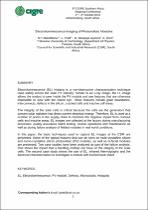JavaScript is disabled for your browser. Some features of this site may not work without it.
- ResearchSpace
- →
- Research Publications/Outputs
- →
- Conference Publications
- →
- View Item
| dc.contributor.author |
Malefafana, MT

|
|
| dc.contributor.author |
Pratt, Lawrence E

|
|
| dc.contributor.author |
Basappa Ayanna, Manjunath

|
|
| dc.contributor.author |
Roro, Kittessa T

|
|
| dc.date.accessioned | 2021-01-17T15:42:08Z | |
| dc.date.available | 2021-01-17T15:42:08Z | |
| dc.date.issued | 2019-10 | |
| dc.identifier.citation | Malefafana, M.T. et al. 2019. Electroluminescence imaging of photovoltaic modules. In: 9th CIGRE Southern Africa Regional Conference, Johannesburg, South Africa, 1-5 October 2019 | en_US |
| dc.identifier.isbn | 978-0-620-86026-0 | |
| dc.identifier.uri | https://cigresa.org.za/event/9th-cigre-southern-africa-regional-conference/ | |
| dc.identifier.uri | http://www.cigresa-events.co.za/symposium_2019/pdfs/CIGRE-Proceedings-2019.pdf | |
| dc.identifier.uri | http://hdl.handle.net/10204/11712 | |
| dc.description | Copyright 2019 The Authors. This is an open access article under the terms of the Creative Commons Attribution License, which permits use, distribution and reproduction in any medium, provided the original work is properly cited. | en_US |
| dc.description.abstract | Electroluminescence (EL) imaging is a non-destructive characterization technique used widely across the solar PV industry. Similar to an x-ray image, the EL image allows the analyst to peer inside the PV module and see features that are otherwise impossible to view with the naked eye. Those features include grain boundaries, interconnects, defects in the silicon, cracked cells and inactive cell areas. The integrity of the solar cells is critical because the cells are the generators that convert solar radiation into direct current electrical energy. Therefore, EL is used at a number of points in the supply chain to minimize the negative impact from cracked cells and inactive areas. EL images are collected at the factory during manufacturing processes, quality assurance batch testing, routine operations and maintenance as well as during failure analysis of fielded modules in real world conditions. In this paper, the basic techniques used to capture EL images at the CSIR are presented. Some of the typical features that can be seen on multi-crystalline silicon and mono-crystalline silicon photovoltaic (PV) modules, as well as bi-facial modules are presented. Two case studies have been analyzed as part of the failure analysis. One shows the impact that a handling mishap can have on the integrity of the solar cells. The second case study shows the use of EL, infrared thermography and the electrical characterization to investigate a module with burned back sheet. | en_US |
| dc.language.iso | en | en_US |
| dc.relation.ispartofseries | Workflow;22397 | |
| dc.subject | Electroluminescence | en_US |
| dc.subject | EL | en_US |
| dc.subject | PV modules | en_US |
| dc.subject | Microcracks | en_US |
| dc.subject | Hotspots | en_US |
| dc.title | Electroluminescence imaging of photovoltaic modules | en_US |
| dc.type | Conference Presentation | en_US |
| dc.identifier.apacitation | Malefafana, M., Pratt, L. E., Basappa Ayanna, M., & Roro, K. T. (2019). Electroluminescence imaging of photovoltaic modules. http://hdl.handle.net/10204/11712 | en_ZA |
| dc.identifier.chicagocitation | Malefafana, MT, Lawrence E Pratt, Manjunath Basappa Ayanna, and Kittessa T Roro. "Electroluminescence imaging of photovoltaic modules." (2019): http://hdl.handle.net/10204/11712 | en_ZA |
| dc.identifier.vancouvercitation | Malefafana M, Pratt LE, Basappa Ayanna M, Roro KT, Electroluminescence imaging of photovoltaic modules; 2019. http://hdl.handle.net/10204/11712 . | en_ZA |
| dc.identifier.ris | TY - Conference Presentation AU - Malefafana, MT AU - Pratt, Lawrence E AU - Basappa Ayanna, Manjunath AU - Roro, Kittessa T AB - Electroluminescence (EL) imaging is a non-destructive characterization technique used widely across the solar PV industry. Similar to an x-ray image, the EL image allows the analyst to peer inside the PV module and see features that are otherwise impossible to view with the naked eye. Those features include grain boundaries, interconnects, defects in the silicon, cracked cells and inactive cell areas. The integrity of the solar cells is critical because the cells are the generators that convert solar radiation into direct current electrical energy. Therefore, EL is used at a number of points in the supply chain to minimize the negative impact from cracked cells and inactive areas. EL images are collected at the factory during manufacturing processes, quality assurance batch testing, routine operations and maintenance as well as during failure analysis of fielded modules in real world conditions. In this paper, the basic techniques used to capture EL images at the CSIR are presented. Some of the typical features that can be seen on multi-crystalline silicon and mono-crystalline silicon photovoltaic (PV) modules, as well as bi-facial modules are presented. Two case studies have been analyzed as part of the failure analysis. One shows the impact that a handling mishap can have on the integrity of the solar cells. The second case study shows the use of EL, infrared thermography and the electrical characterization to investigate a module with burned back sheet. DA - 2019-10 DB - ResearchSpace DP - CSIR KW - Electroluminescence KW - EL KW - PV modules KW - Microcracks KW - Hotspots LK - https://researchspace.csir.co.za PY - 2019 SM - 978-0-620-86026-0 T1 - Electroluminescence imaging of photovoltaic modules TI - Electroluminescence imaging of photovoltaic modules UR - http://hdl.handle.net/10204/11712 ER - | en_ZA |






